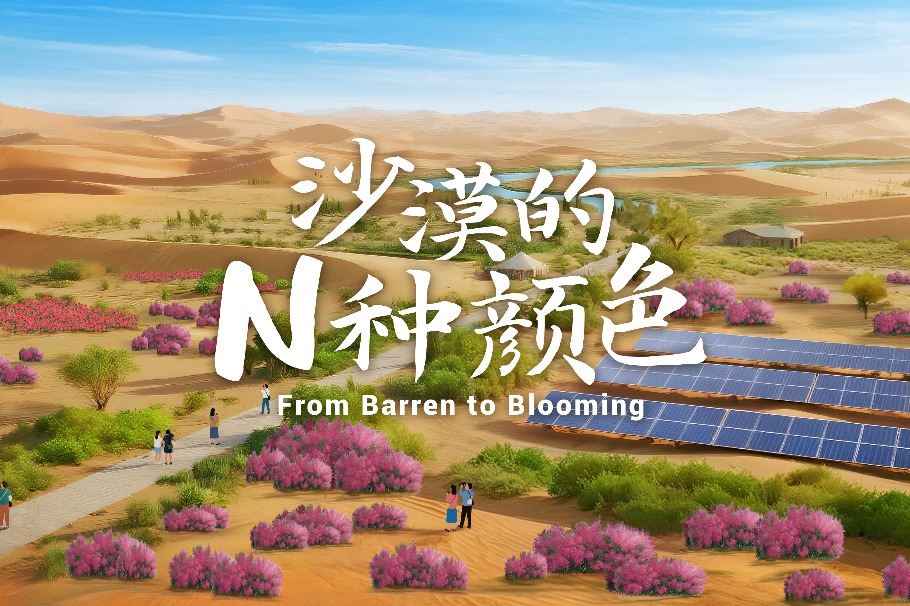Travel, business bloom from desert railway

Editor's note: Improved infrastructure, policy support and funding in areas with large populations of different ethnic groups have transformed people's lives. China Daily presents a series of stories about how China is determined to leave no ethnic group behind in the country's development, while inspiring them to embark on a new journey and make achievements in the new era. This article is the first installment, focusing on transportation in Xinjiang. It is also the ninth installment in a series of visual stories that highlight the important points on China's path to modernization.
Gulbar Herem enjoyed sitting by the window while taking the train back to her home in Qira county, Hotan prefecture, because she found the passing view of huge sand dunes breathtaking and surreal.
Outside the window, the Taklimakan Desert in the Xinjiang Uygur autonomous region flashed by as the train made its way along the railway tracks.
"We are actually traveling through the desert that is literally called 'the place with no return'. I still cannot believe it's even possible," Gulbar said, while taking her cellphone out to capture the moment the train passed a stretch of poplar trees brightening the desert with their golden leaves and creating a picturesque autumn landscape against the blue sky.
It was only when a crew member of the 5817 train service operating from the regional capital of Urumqi to Hotan reminded her that the train would soon arrive at her destination, that she realized the Qira people's dream of having a train service at their doorstep was now a reality. Their lives immediately changed when the railway opened on June 16, 2022.
The Hotan-Ruoqiang railway stretches eastward from Hotan to Ruoqiang county in the Bayingolin Mongol autonomous prefecture along the southern edge of the Taklimakan, the world's second-largest shifting sand desert. About 65 percent of the railway is within the desert.
The 825-kilometer section also completed the 2,712-km-long Taklimakan Desert rail loop, making it the first desert rail loop in the world.
The opening of the line, which is a key national railway project, brought train services to five counties — Qira, Lop, Yutian, Minfeng and Qiemo in southern Xinjiang — and shortened the travel time for locals.
Before the new railway opened, to get to Urumqi from Hotan people had to use the train service that travels along the northern edge of the Taklimakan and takes about 34 hours.
Now, they don't need to make such lengthy detours. With a designated speed of 120 km per hour, the traveling time has been cut by about 10 hours. For Gulbar, a schoolteacher, her journey to Qira only took about 20 hours.
"The Hotan-Ruoqiang railway has been the talk of the town since its construction started in December 2018. And people including me have been closely following the progress of the news. Now, it has become an important part of our lives," she said.
Wider horizons
As Gulbar got off the train at Qira, more people got on, and the train was soon packed again. Many people were wearing colorful traditional Uygur customs and carrying naan bread and roasted mutton. The aroma of the food quickly filled the train car.
A lot of the travelers told train conductor Zhao Hong, who was busily helping them find their seats, that they were taking the train to visit relatives in another county.
More and more people have started to take short train trips to other counties because it's convenient and cheap, Zhao said. "We didn't expect to see the new service be this popular. Many people are taking the train for the first time in their lives as train services have just become available in their home counties. You can see the excitement in their eyes," she said. "They even bring us gifts such as walnuts and mutton to show how happy they are about the new railway that they've always wanted."
Akbar Turson, a passenger from Lop aged in his 40s, said the new line has cut travel costs for locals and made the journey much safer.
Before the train service became available in Lop, people often chose to take a long-distance bus to Urumqi, which cost about 500 ($70) to 600 yuan. The cheapest train ticket is only about 170 yuan and, Akbar said, people no longer need to worry about road accidents.
"Now, people in Lop can easily travel elsewhere by train to find new opportunities or just go sightseeing in other places. In fact, the new line isn't only about adding a way of traveling, it has made people, especially young people, see China's determination to develop Xinjiang," Akbar said.
Abdulret Abdulhabar, also from Lop, took the train back home after visiting Urumqi for the first time. "I finally decided to travel to Urumqi with my friends because the new train service is fast and comfortable," the 21-year-old said. "I'd love to travel more in the future because I can see more new things."
























